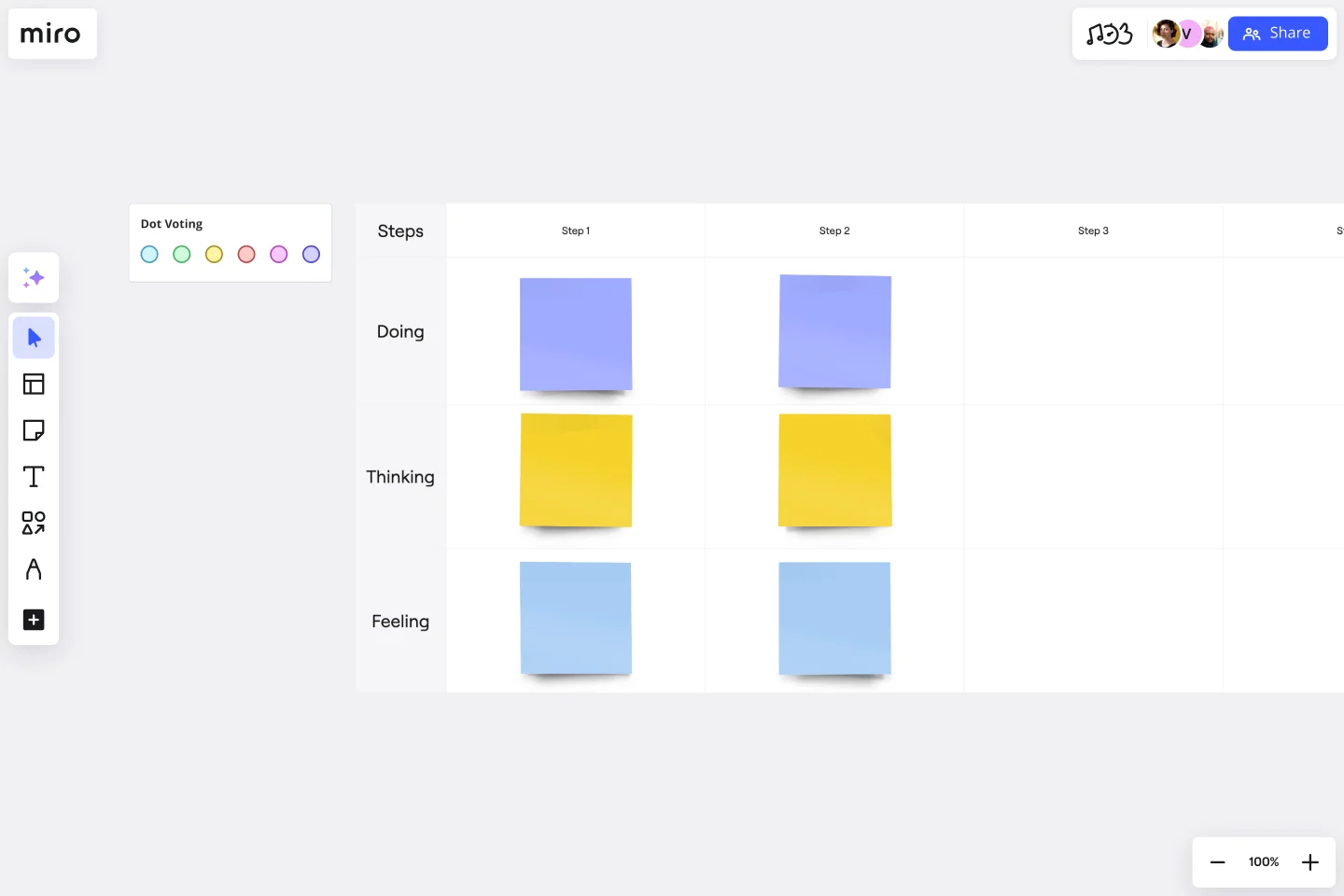Scenario Mapping Template
Create a guide to what personas are doing, thinking, and feeling in different situations.
About the Scenario Mapping Template
Scenario mapping is the process of outlining all the steps a user will take to complete a task. It generally includes notes about what users are thinking and feeling at each step. It can also include comments or information you feel is important for each step, questions or assumptions you have — as well as suggestions that come up as you go through this exercise.
Miro's scenario mapping template is divided into four quadrants to guide you through the exercise:
Steps (the structured framework of what is being done)
Doing (the practical application of the task)
Thinking (cognitive processes behind the task)
Feeling (emotional and subjective aspects)
When should you do scenario mapping?
Scenario mapping can be used both to outline the intended or ideal scenario (what should happen) as well as what currently happens.
If you’re trying to outline the ideal scenario, user mapping should take place very early on in a project and can help inform user stories and the product backlog. If you’re just trying to get a better sense of what currently happens, you can do scenario mapping when conducting user interviews or observation.
How do you use the scenario mapping template?
Scenario mapping is made simple with Miro's template. Follow these steps to use it effectively:
Start by explaining the purpose of the scenario mapping session. The goal of scenario mapping is to identify what your users will do, not how they will do it. You can sketch out the details later. Set these expectations up front.
Identify one of your primary user personas and a key task that they will accomplish. What do you want your user to do? What is their goal?
Contextualize the scenario. Make a note of who the persona is, what they’re doing, why they’re doing it, and how often. Remember, don’t get too bogged down in the details. But it’s a good idea to keep these elements in mind as you move forward.
Walk through each step your user might take. As a group, visualize the user’s pathway on your site. At each step, you’ll want to capture the following information: What does the user do? Are there any assumptions or question you need to resolve at this step? How can you make this step more user-friendly?
Map out your steps. Most people prefer to map each step from left to right and add comments, ideas, and suggestions below each step.
Repeat until the user has completed their task.
Gather feedback from stakeholders and potential users. Ask them to walk through each step and see if they make sense. Is something missing? Do they have any additional thoughts or suggestions?
Get started with this template right now.
User Story Mapping with Walkthrough
Works best for:
Customer Journey Map
The Bluefruit Software user story mapping template offers a framework to help businesses prioritise software development.
Kaizen Report Template
Works best for:
Agile Methodology, Operations, Documentation
What makes a great company great? They know that greatness needs to be fostered and maintained — meaning they never stop working to improve. If you’re one of those companies (or aspire to be), a kaizen report is an ideal tool. It creates a simple visual guide to continuous improvement activities on a team, departmental, and organizational level. Using a kaizen report approach, every employee in an organization audits their own processes and understands what they might have overlooked, making this a powerful tool for increasing accountability at all levels.
Good, Bad, Ideas, Action, Kudos Retrospective
Works best for:
Retrospectives, Meetings, Agile Methodology
The Good, Bad, Ideas, Action, Kudos Retrospective template offers a structured approach to retrospectives by categorizing feedback into five key areas: good, bad, ideas, action items, and kudos (appreciations). It provides elements for team members to share their thoughts, suggestions, and acknowledgments. This template enables teams to reflect on past performance, generate actionable insights, and celebrate achievements. By promoting inclusivity and constructive feedback, the Good, Bad, Ideas, Action, Kudos Retrospective empowers teams to foster collaboration, drive continuous improvement, and strengthen team dynamics effectively.
PEST Analysis Template
Works best for:
Ideation, Strategic Planning, Business Management
No business operates inside a vacuum, so if you want to succeed, you have to successfully deal with local laws, government regulating bodies, the health of the local economy, social factors like the unemployment rate, average household income, and more. Use the PEST Analysis Template to help you explore how the world impacts your business and how you can work around it.
Plus Delta Template
Works best for:
Software Development, Meetings, Retrospectives
The Plus Delta template is a simple but powerful tool for collecting constructive criticism from a group. The format encourages you and your team to focus on what went well, what you should repeat in the future, and what you should aim to change. To complete a Plus Delta template, simply make note of things that are working and things you would like to improve. You can then file these elements into two separate columns. Use Plus Delta to showcase wins and learnings for your team, stakeholders, employees, and bosses.
Executive Summary Template
Works best for:
Leadership, Project Management, Documentation
Pique their curiosity. Get them excited. Inspire them to keep reading, diving further into your proposal details. That’s what a good executive summary has the power to do—and why it’s a crucial opening statement for business plans, project plans, investment proposals, and more. Use this template to create an executive summary that starts building belief, by answering high-level questions that include: What is your project? What are the goals? How will you bring your skills and resources to the project? And who can expect to benefit?
